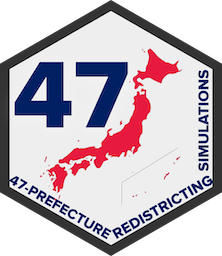47-Prefecture Redistricting Simulations
 Comprehensive project to simulate alternative legislative redistricting
plans of House of Representatives for all 47 prefectures in
Japan.
Comprehensive project to simulate alternative legislative redistricting
plans of House of Representatives for all 47 prefectures in
Japan.
 Comprehensive project to simulate alternative legislative redistricting
plans of House of Representatives for all 47 prefectures in
Japan.
Comprehensive project to simulate alternative legislative redistricting
plans of House of Representatives for all 47 prefectures in
Japan.
日本語 / English
The goal of the 47-Prefecture Simulation Project is to generate and analyze redistricting plans for the single-member districts of the House of Representatives of Japan using a redistricting simulation algorithm. Redistricting simulation algorithms can be used to redraw legislative districts in a transparent manner while following redistricting rules such as criteria on geographic compactness and population parity. For this project, we use an open-source software package redist, which was developed by the Algorithm-Assisted Redistricting Methodology (ALARM) Project.
Currently, the Council on the House of Representatives Electoral
District (hereafter “the Council), a commission that proposes
redistricting plans for the single-member districts of the House of
Representatives, is revising district boundaries based on the 2020
Census. The Council is mandated to redraw district boundaries so that
the nation-wide maximum-minimum ratio of voters per district falls under
2.
Specifically, the number of Japanese citizens in the largest district in
Japan must be no larger than twice the number of Japanese citizens in
the smallest district in Japan. In this redistricting cycle, districts
will be redrawn in 19 prefectures where 5 prefectures will gain seats,
10 prefectures will lose seats, and 4 prefectures will neither gain nor
lose seats but will be subject to redistricting.
In this project, we use a redistricting simulation algorithm to generate redistricting plans that both limit the number of split municipalities and minimize the voting weight disparity within each prefecture. Our simulations are designed to comply with the redistricting rules that the Council abides by. We will start with the 19 prefectures subject to redistricting and plan to expand the scope of our research to all 47 prefectures.
You can view the results of our analyses by clicking on a prefecture of interest below. Each prefecture page presents the summary of our analysis, an example plan, and link to the code and data used for our analysis.
We acknowledge the partial support from the Edwin O. Reischauer Institute of Japanese Studies (RIJS) at Harvard University. We also thank Harvard Data Science Initiative and Microsoft for computational support.
Unless otherwise noted, data for each prefecture comes from the 2020 Japapnese Census (令和2年国勢調査) and the 2015 Japanese Census (平成27国勢調査) from the Statistics Bureau. In these cases, shapefiles are also taken from the Census.
Also, for the additional geographical information used in this analysis (ferries, lakes, etc.) comes from Ministry of Land, Infrastructure, Transport and Tourism, and polygon files for the current legislative districts used for mapping comes from Center for Spatial Information Science, at the University of Tokyo.
All data is available on our Dataverse and has been released to the public domain. Code is available on GitHub under an MIT license.
If you see mistakes or want to suggest changes, please create an issue on the source repository.
For attribution, please cite this work as
Miyazaki, et al. (2022, April 23). 47-Prefecture Redistricting Simulations . Retrieved from https://doi.org/10.7910/DVN/Z9UKSH
BibTeX citation
@misc{miyazaki202247-prefecture,
author = {Miyazaki, Sho and Yamada, Kento and Yatsuhashi, Rei and Imai, Kosuke},
title = {47-Prefecture Redistricting Simulations
},
url = {https://doi.org/10.7910/DVN/Z9UKSH},
year = {2022}
}